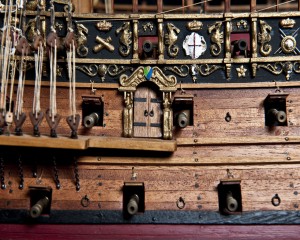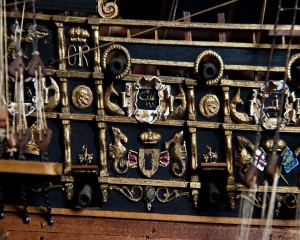Sovereign of the Seas: Mastering the Gun Drill
The Sovereign of the Seas was a warship, so her crew spent a great deal of time practising their gun drill. A 24-pounder long gun would be manned by a crew of twelve men, plus a powder boy, each of which would have other duties if called away from the gun to board other ships, resist boarders, or man a fire crew. When a warship such as the Sovereign of the Seas prepared for action there would be a call for silence as the men were ordered to man the guns. Each would take up his position alongside the gun, with the powder boy standing a safe distance behind it.

Then a series of sixteen orders were given:
1. “Pull back your piece.”
The muzzle lashings that secured the gun when it was not in use were untied. A recoil rope was then looped around the cascabel, the large round knob on the rear of the barrel. This was secured to ring bolts in the bulwark on either side of the gun port. Beaching tackle was connected to the sides of the gun carriage and, again, connected to iron ring bolts on the bulwark on either side of the gun port. These were slacked off, while the train tackle connecting the rear transom of the gun carriage to standing block bolted to the deck was used to haul the gun inboard.
2. “Order your piece to load.”
The tampion – a block of wood or cork covered with tallow that was rammed into the end of the gun barrel to protect it when not in use – was then removed.
3. “Search your piece.”
The vent at the rear of the barrel where the charge is ignited was cleared with an iron spike or a piece of wire called a priming iron, vent auger or simply a pricker, while an iron worm shaped like a corkscrew was pushed down the barrel and turned to remove any debris left behind from previous firings.
4. “Sponge your piece.”
Once the gun had been fired, the barrel had to be cooled and any sparks or embers extinguished to prevent the premature ignition of the next charge of gunpowder. So a wad of lamb’s skin attached to a wooden pole was dipped in water and thrust down the barrel.
5. “Fill your ladle.”
A copper half cylinder with a wooden handle was filled from the power keg.
6. “Put in your powder.”
The ladle was then pushed down the barrel.
7. “Empty your ladle.”
The half-cylinder carrying the powder was turned over, depositing the powder at the bottom of the barrel. Despite the sponging, this was a dangerous operation. The powder could explode on contact with the hot metal inside the gun barrel, so the loader stood to one side during this procedure.
During a battle at sea, the gun decks would be awash with spray and sparks would be flying from the other guns.
8. “Put up your powder.”
The wooden lid was put back on the powder keg and it was moved away for safety’s sake.
9. “Thrust home your wad.”
A wad of old rope, known as junk, was put into the barrel. In 1655, the gunner’s store of the Sovereign of the Seas, then renamed the Sovereign by Cromwell’s government, carried two-and-a-half tons of junk for this purpose. The wad was then forced down the barrel with a rammer – wooden cylinder on the end of a pole – compacting the charge behind it.
10. “Regard your shot.”
A shot was taken from the rack that extended the length of the gun deck and put into the muzzle of the gun.
11. “Put home your shot gently.”
The rammer was then use push the shot down the barrel until it rested firmly against the wad.
12. “Thrust home your last wad with three strokes.”
A second wad was then forced down the barrel with the rammer, further compacting the charge and securing the shot firmly in position. This was crucial and judging the precise amount of ramming was the true art of the gunner.
13. “Prime your piece.”
The vent was cleared with the pricker a second time, then a pound of a particularly fine and volatile preparation of gunpowder, known as serpentine powder, was pouring into the vent from a powder horn. The gunner then covered the vent with a sheepskin or a lead apron. This was to both keep the powder dry and prevent any stray sparks igniting the charge. During a battle at sea, the gun decks would be awash with spray and sparks would be flying from the other guns.
14. “Run out your piece.”
The lashing securing the cover of gun port were released and the cover was opened by a hoist, which was then secured. Then the gun crew hauled on the breeching tackle to run the gun forward until the muzzle emerged through the open gun port.
15. “Gauge your piece.”
The gun was then aimed roughly using the breeching tackle. Fine adjustment was made using handspikes. These were wooden levers about five or six feet long, tapered at one end, flattered at the other, used to traverse the gun. The elevation was controls by a wooden wedge called a quoin, jammed between rear of the barrel and the rear transom of the gun carriage.
16. “Fire.”
The protective sheepskin or apron was removed and the powder in the vent was ignited with a linstock. This was staff with a slow match – a burning piece of cord – at one end and a spike at the other that could be stuck in the deck when not in use. The serpentine powder would then detonate the main charge, propelling the shot out of the barrel. The gun would then recoil violently until it was restrained by the recoil rope. Then the procedure would start all over again.
With up to forty-four guns on a gun deck, the noise would have been deafening. The recoil from repeated broadsides would have put a terrible strain on the ship and a psychological strain on the crew. They would be wreathed in the powder smoke and in almost as much danger from the Sovereign’s own guns as the enemy’s.







